Home »
Misc »
How to break the press in youth basketball
How to break the press in youth basketball
1-4 Press Break to Score on Any Full-Court Defense
There are many factors that go into winning and losing basketball games:
- Shooting
- Rebounding
- Free Throws
- Press Break Offense
However, at the high school level and below, I don’t think anything will lose a game faster or more frequently than a team’s inability to handle pressure.
We've probably all had teams that have excelled in a controlled half court game, but immediately lost their poise when the opponent began to press.
As a coach, there’s nothing more frustrating than helplessly watching from the sidelines as your team commits countless turnovers when the other team extends its defense.
But it doesn’t have to be this way!
One of the most important jobs a basketball coach has is to equip players with the skills, mindset, and alignments needed to attack pressure.
Each of these elements is crucial – without one, the other two are not nearly as effective.![]()
The 1-4 press break is one sound way of attacking man or zone full court pressure.
Check out the diagrams and options below to see if this type of attack will work for your team.
Utilizing the 1-4 Press Break
One of my favorite ways to attack full-court pressure (man or zone) is with the 1-4 press break.
Below I’ll tell you why you should use it and I’ll show you how it works.
Let’s get started:
Benefits of the 1-4 Press Break:
a. Can be Effective Against Man and Zone PressesThe best press break alignments are versatile. Against a team that changes defenses, you don’t want your players looking to the sideline waiting for a play call. The 1-4 alignment eliminates that confusion because it can be used against any pressing defense.
b. The Alignment Makes Denial More DifficultSome pressing teams try to deny all inbound passes. If your alignment has players deep down the floor, the defense will be able to do this more effectively.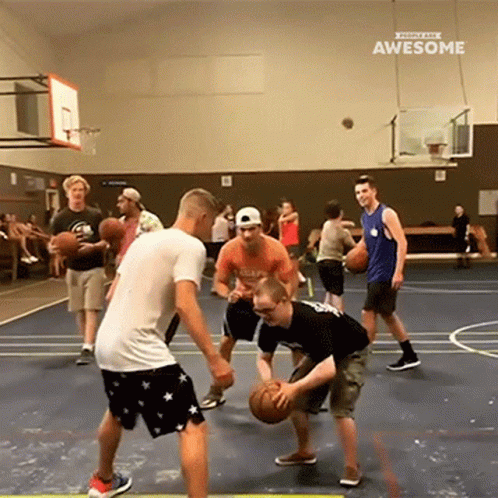 By bringing all players up, it eliminates back side help, opening up potential deep passes if the defense denies.
By bringing all players up, it eliminates back side help, opening up potential deep passes if the defense denies.
c. Forces Opponent’s Post Players to Defend Full CourtThis is another benefit of bringing everyone up against a press. Opponents will need to make a choice: Do I bring up everyone, including a potentially slower post player, or do I just let the ball inbounds? Against many teams, either option could benefit the offense.
d. You Can Attack to ScoreMost 1-4 press breakers eventually send a player down the floor. This still allows your team to hunt layups after it breaks the press. In fact, having a player start high and then break down the floor is more difficult to guard than simply stationing a player deep for the whole possession.
e. It’s FlexibleThere are many things you can do out of a 1-4 alignment. We will show a few options in the next section, but you can use your imagination to adjust the press breaker to fit the personnel on your team.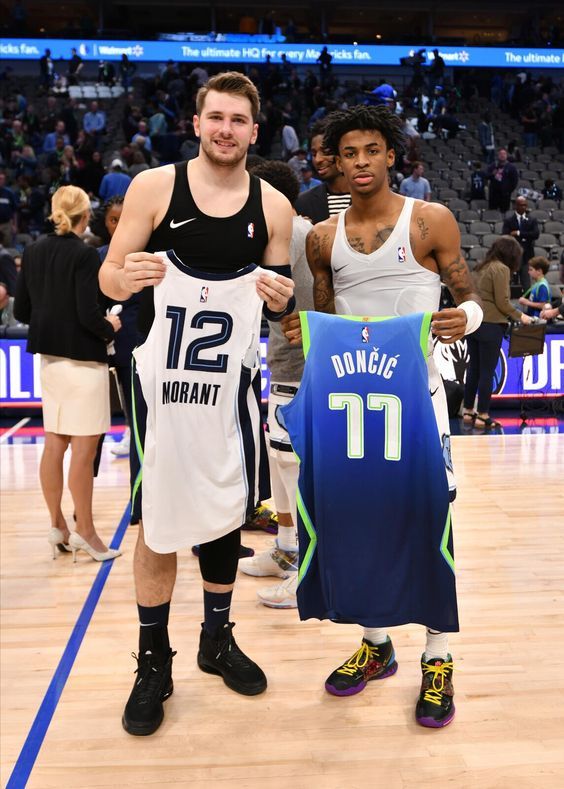
1-4 Press Breaker Options:
Option #1: 1-4 Alignment vs. Zone PressureCommon zone presses include the 2-2-1, 1-2-2, and 1-2-1-1 presses.
This alignment can be effective against any of these looks.
Consider the best way to use your personnel.
For example, do you want your point guard to receive the first pass, or would you rather he or she attack up the floor on the second pass?
In the diagrams below, notice how the offense maintains sideline, middle, reverse spacing.
In these diagrams, the fifth player is used in the “deep diagonal” position.
If the ball is reversed, players fill both sidelines and the middle.
Option #2: 1-4 Alignment vs. Man-to-Man PressureAgainst man pressure, you probably want to set screens to help your players get open.
This can be done in many ways, but one option is diagrammed below.
Again, players can be positioned however suits your team, but notice one important detail in the diagram:
Player 5, typically a post player, sets the second screen for Player 1, the point guard.
This is usually a good idea because two advantages could be created against a switching defense.
First, your point guard will usually be quicker than the opposing post player.
Second, your post player should be able to seal an opposing guard.
Another possibility is for Player 5 to screen his or her own defender, making the switch more difficult.
If the ball is inbounded to a good ball-handler, you can clear out of their way vs. a man-to-man defense.
Some defenses will not trap, instead choosing to pressure the ball handler 1-on-1.
If this is the case, your guard should not have trouble and it is better to give them space.
Some teams will let the ball handler start to dribble, then will leave from another player and trap. This is where the pullback dribble is necessary.
In the diagrams below, notice how, as the trap occurs, Player 1 uses a few pullback dribbles and the other teammates are “pulled” to the ball handler into the sideline, middle, reverse position.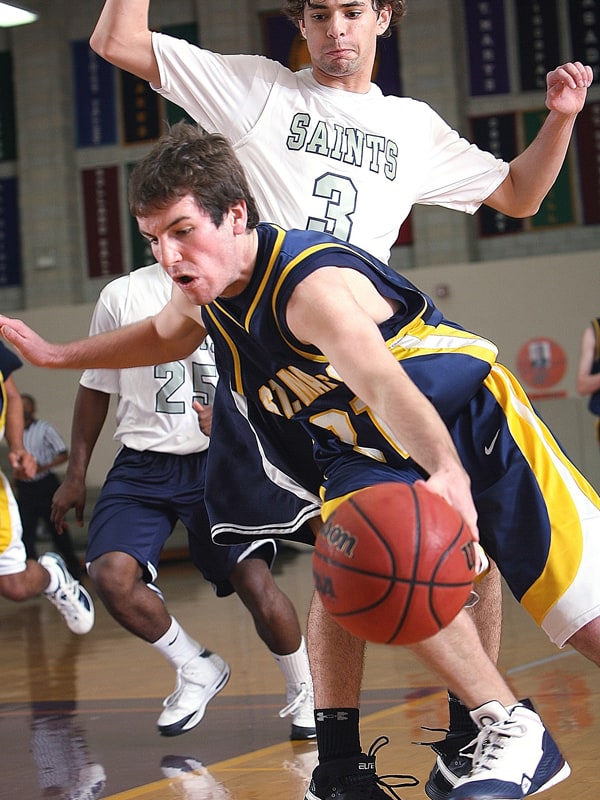
Option #3: 1-4 Alignment vs. Extreme DenialTeams that completely sell-out to deny the inbound pass can be very difficult to play against.
While the second option can certainly be effective against these teams, you may want to have another option as well.
This look is good for teams that negate your screening actions with effective switching.
For example, athletic teams with five players of similar size and quickness may be able to switch without giving up significant size or speed disadvantages.
Against those teams, it may be smarter to maximize space rather than setting a lot of screens.
In the diagrams below, the defense is in a full court man-to-man face-guarding defense with the inbounder’s defender playing “centerfield.”
The offense counters by all four potential pass receivers walking their defenders as close to the baseline as possible. This shortens all passing options and creates even more space to operate.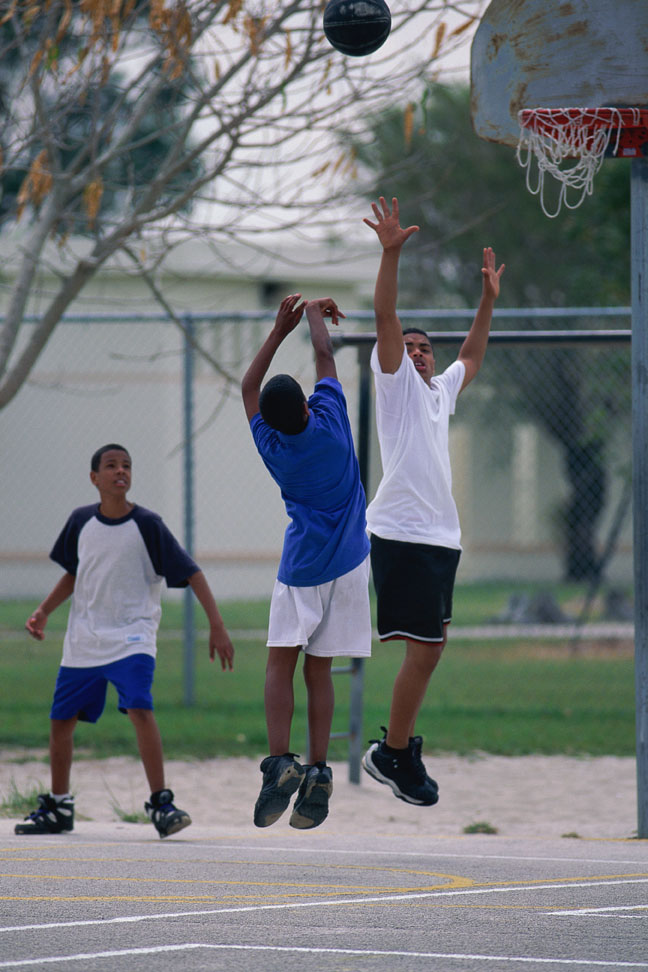
Once the ball is inbounded, all offensive players should have an advantage.
The ball-handler can simply read the centerfielder and pass the ball ahead.
This is a great way to alleviate pressure by forcing the defense to become less aggressive.
8 Press Break Tips and Skills to Master:
a. Screen and Seal vs. DenialNo press breaker will be effective if you can’t inbound the ball safely.
If you’re facing a team that denies the inbound pass, you probably want to utilize screens to help free your ball-handlers.
However, your screeners MUST be ready to receive a pass after screening.
This is because many pressing defenses will switch all screens.
If a player screens a teammate’s defender, he or she should pivot in a way that keeps the switching defender on their back.
b. Screen Your Own Man vs. SwitchesAnother strategy against a switching defense is to screen your own defender.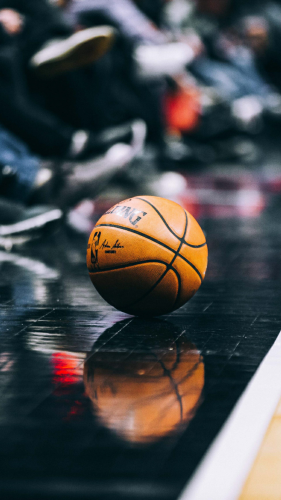
Think about it...
If the defense wants to jump out and switch on all screening actions, screening your own defender makes it difficult for them to do that.
This type of screen can free a teammate to receive the ball.
c. Run the Baseline After MakesFinding a good inbounder is sometimes difficult.
One simple habit to teach your inbounders is to run the baseline after a made basket by your opponent.
If the strong side of the floor is not open, the inbounder can run to the other side to explore options there.
This shortens a potential pass to the opposite side.
d. Sideline, Middle, ReverseThis is a crucial part of attacking man or zone presses that like to trap.
Any time there is a trap, you want (1) sideline, (2) middle, and (3) reverse options.
Some coaches like the fifth player to be diagonal, while others prefer him or her to be deep.
Regardless, these first three options are essential.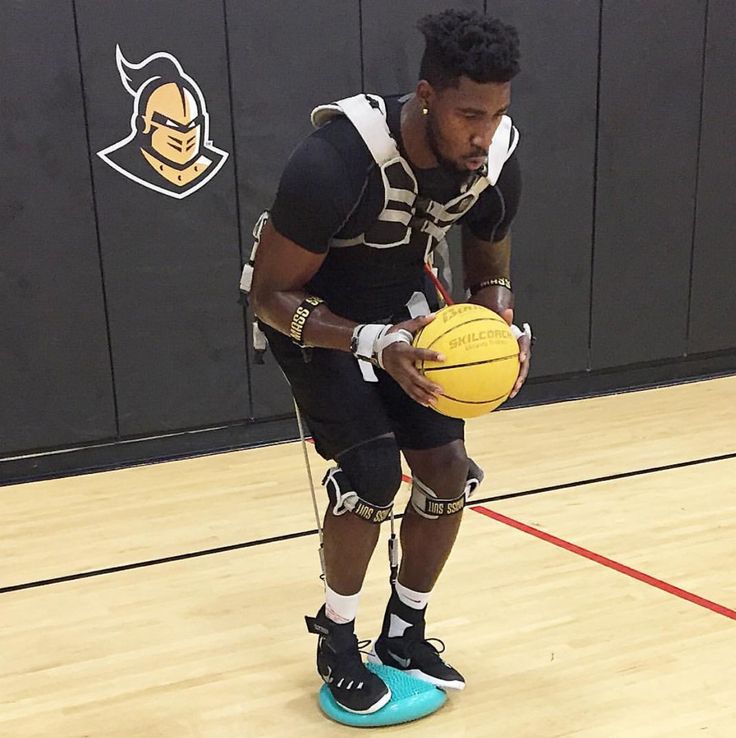
This is because it is very difficult for the defense to put two players on the ball while still covering sideline, middle, and reverse options.
With proper spacing, the player being trapped must simply remain poised and find the open teammate.
e. Use Ball FakesFull court presses are, by nature, aggressive defenses.
Jumpy defenders can be moved and manipulated with clever ball fakes.
If you want to pass to the middle, fake a pass up the sideline, or vice versa.
Ball fakes can take some of the aggression out of a defense.
f. Pullback Dribble vs. TrapsThis is the most important type of dribbling against trapping defenses.
Many man or zone presses attempt to bait the ball handler into dribbling before coming to trap.
This is fine.
Good players don’t mind being trapped because they know that traps create openings for the offense. However, you must create space to make those passes.
Pullback dribbles allow you to get that space.
Execute a pullback dribble by turning your shoulders so that the ball is behind you, putting your chin on your top shoulder so that you can see the floor, and taking big push steps back to create space.
As a ball handler uses a pullback dribble, his or her teammates should come back to the ball to shorten the pass. Think of it as the ball handler pulling teammates toward them.
Skilled ball handlers may be able to pullback and attack the other direction off the dribble (“pullback and reattack”), but most players will want to beat the press with the pass.
g. Play With Your Eyes UpThis sounds simple, but it is harder to execute when facing a double-team.
Players must be trained to maintain vision of the floor.
Most full court presses leave a player, sometimes multiple players, open down the floor.
The problem is that ball handlers panic and simply don’t see them.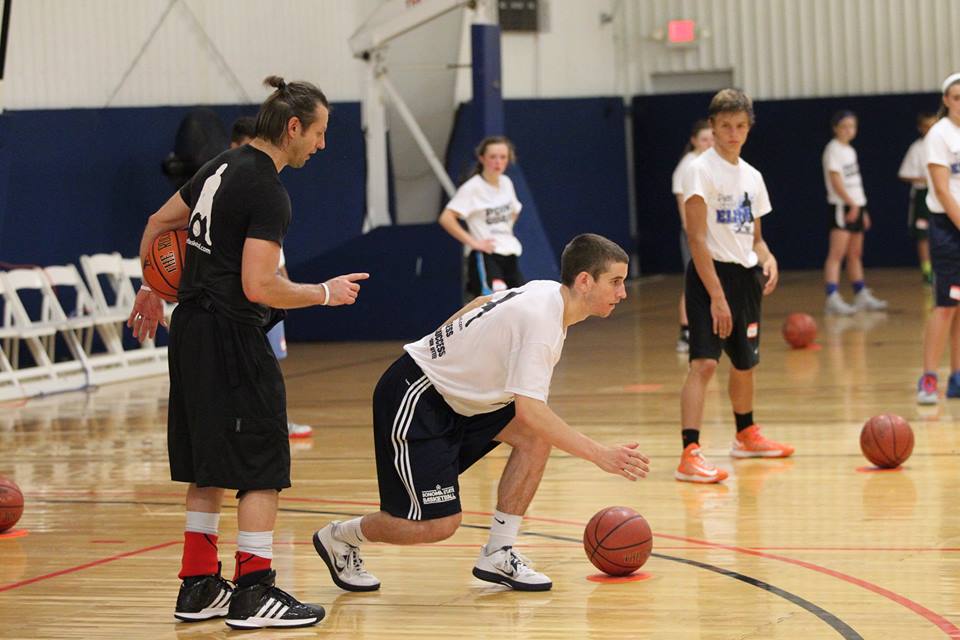
Emphasize vision in practice and reinforce it through the use of film so that your players learn the importance of seeing what options are available.
h. Score Early or Late in the ClockTeach your players that the goal of press offense is to SCORE!
If you are content with simply getting the ball across half court and running offense each possession, there is no risk for the defense and they will just press more aggressively.
However, shot selection is crucial when playing against full court pressure.
Your first priority should be attacking the press for a layup.
If a layup (or a quality shot from a good shooter) does not materialize, then you can run your offense and seek a better shot.
Remember, many pressing teams want to speed you up.
If your press offense only creates quick long-range jump shots, you are probably playing right into the hands of the defense.
Conclusion:
At some point in your season, you will encounter a team with strong full court pressure.
Will your players be intimidated, or will they feel prepared to attack the defense for layups on the other end?
By emphasizing the proper skills, mindset, and alignments, you can prepare your team to excel in these high-pressure moments.
Basketball Press Breaker
Summary
This press breaker works extremely well against teams that pressure the inbounds pass. If your team is struggling to get the ball inbounds, try this play and I can almost guarantee you'll see a big difference and reduce turnovers.
Personnel
Player #5 and #4 are generally your post players. Players 1, 2, and 3 should be your best ball handlers.
Instructions- Start by simply lining up your players as shown in the diagram.
- If you're facing a zone press that is pressuring the inbounds pass, you'll find that you'll be able to easily inbounds the pass to one of the outside players.
 If you're facing a full-court man-to-man press that is denying the inbounds, you'll want your outside players to break down the court as shown in the diagram below. - Assuming the ball was not immediately thrown to one of the outside players, you'll want Player 1 and Player 2 to set screens for each other trying to get open.
TIP: If the defense is denying the inbound pass, teach your guards to position their body between the passer and their defender. It's just like a post player using their pivot to establish position and seal their man to get the ball. This is an extremely effective method to get open. Simply back pivot into the defender, seal him behind you, and call for the ball. - If the ball is thrown to Player 1 or 2, then the rest of the team should get in their press breaker positions and work the ball down the court. If it's man-to-man, everyone should clear out and run down the court so the guard can bring the ball up.
- If the ball is thrown to an outside player, follow the sequence in the diagrams.
 - Once Player 4 receives the ball, Player 2 should cut and run down the court looking for the ball. If he's open, Player 4 should pass him the ball and Player 2 might be able to dribble all the way down the court.
- Player 3 should maintain spacing and cut a split second after Player 1 begins to run down the court. Many times, Player 3 will be wide open for the pass because the previous cut drew the defensive players away. If open, Player 3 might be able dribble all the way down the court for an easy fast-break opportunity.
- Once the ball is passed to Player 2 or 3 and they could not dribble up the court, the other players should get in their normal press breaking positions (assuming it's a zone press).
The pass usually goes to Player 3. This diagram shows the positioning in that situation. - Player 3 should immediately look at Player 5 running down the court. Many times all the cutting on this side of the court opens up the other side, sometimes for a lay-up.
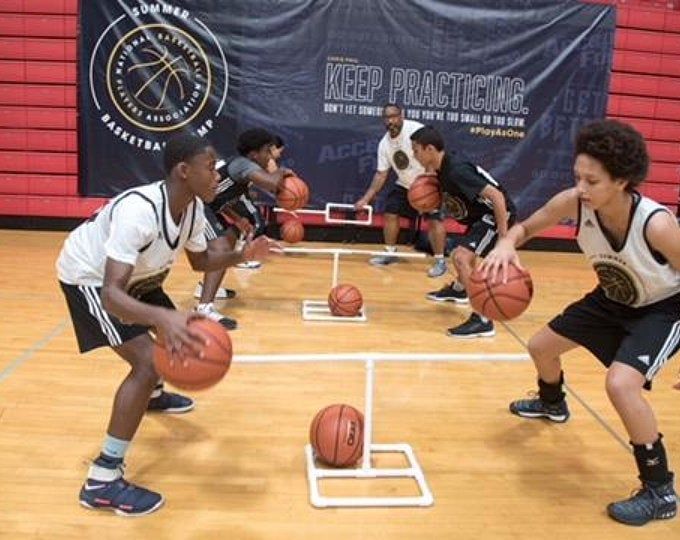 If Player 5 is not wide open, look to the middle for Player 2 coming back to the ball. Advance the ball to Player 4. Or reverse the ball to Player 1. - Keep reversing the ball until you can advance the ball up the court or hit the player in the middle.
* The best thing about this play is that by lining up your players at the beginning, it's much easier to inbound the ball against pressure. And the cutting afterwards really opens up the court, especially if you have a couple players that can really run and handle the ball.
|
|
|
For a press breaker offense and strategy to avoid turnovers, you can reference Universal Press Breaker Offense & Strategy
What do you think? Let us know by leaving your comments, suggestions, and questions...
Subscribe to our free monthly newsletter to receive new drills, plays, scoring tips and coaching strategies,
plus three free eBooks with over 270 pages of our favorite basketball drills and plays!
"In Russia, children are not sent to basketball because of the dominance of legionnaires" | Articles
Yaroslav Korolev's career developed rapidly.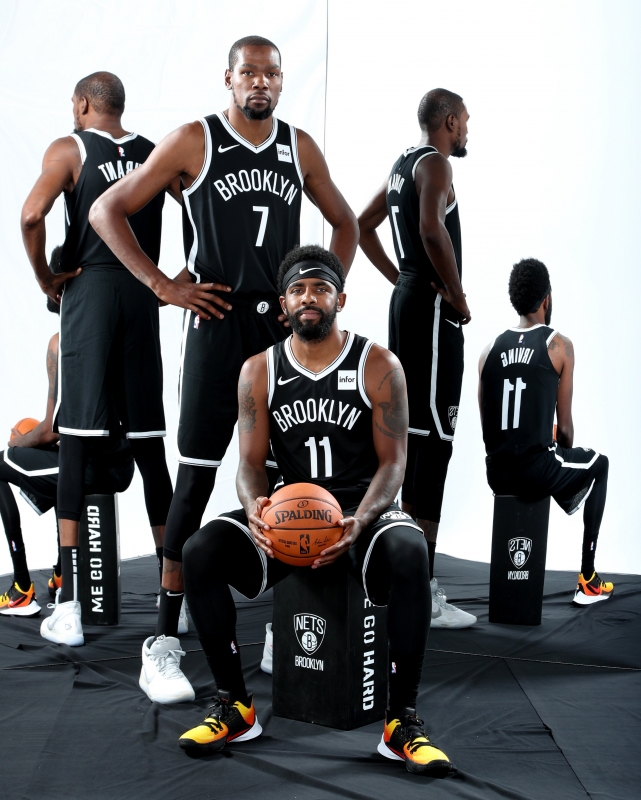 He showed an outstanding game at the 2003 European Junior Championship in Belgrade (our team then took bronze) and was the leader of CSKA in the victorious youth Euroleague 2005. As a result, the Los Angeles Clippers selected 18-year-old Yaroslav under the high 12th number (a record among Russian players in the history) of the 2005 NBA draft. But he failed to build an impressive career. For two seasons, the basketball player played 34 games in the NBA, never becoming a full-fledged player in the rotation of the Californians.
He showed an outstanding game at the 2003 European Junior Championship in Belgrade (our team then took bronze) and was the leader of CSKA in the victorious youth Euroleague 2005. As a result, the Los Angeles Clippers selected 18-year-old Yaroslav under the high 12th number (a record among Russian players in the history) of the 2005 NBA draft. But he failed to build an impressive career. For two seasons, the basketball player played 34 games in the NBA, never becoming a full-fledged player in the rotation of the Californians.
Yaroslav Korolev returned to Russia, where he played for Dynamo under David Blatt, tried to return to the NBA through the Development League, and also managed to play in Spain, Greece and the United League. At the age of 29, the basketball player ended his career. Now Yaroslav lives in Los Angeles, but often visits Moscow. In an interview with Izvestia, he spoke about his new job, the prospects of Maria Vadeeva in the WNBA, the mistake of the Lakers club that signed LeBron James, and the problems of domestic basketball.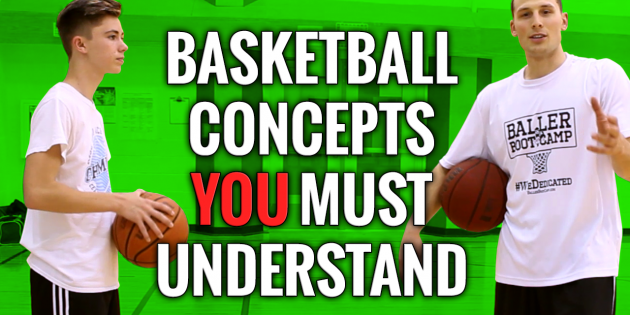
— You haven't given an interview for a long time. What is Yaroslav Korolev doing now?
- I have my own basketball school in Los Angeles, with a full-fledged coaching staff, a manager. We work with children aged 3 to 13, giving them in-depth training in all aspects of basketball. We have both a beginner level and 8-10-year-old children already working in teams. Games are played on Sundays. Once a month, we go to a tournament, the essence of which is simple: three matches are played on Saturday, according to their results, you either go to the playoffs for the games on Sunday, or you go home.
In addition, we also train trainers for schools that work on an after-school program. If the school and the children are interested in learning more about basketball, we send one or two specialists to the school. It must be understood that this is not an additional physical education lesson when a teacher throws a ball to 20 children, and they do what they want.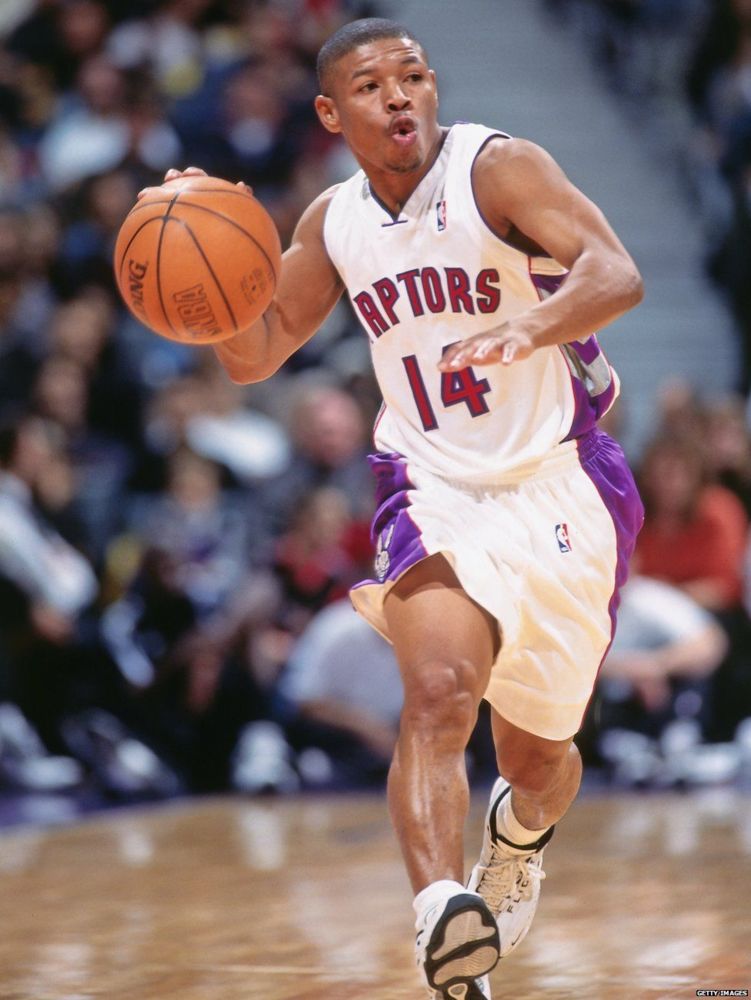 We have each coach working with a maximum of 10 children for one hour, but this time is very busy and as productive as possible. 15-20 minutes - dribbling, 15-20 - passes, then - throws. If the place in the school allows, children can play, but it is important to take into account one point: this is an after-school program, and the level of training of students is very low.
We have each coach working with a maximum of 10 children for one hour, but this time is very busy and as productive as possible. 15-20 minutes - dribbling, 15-20 - passes, then - throws. If the place in the school allows, children can play, but it is important to take into account one point: this is an after-school program, and the level of training of students is very low.
- If we consider any education as a kind of social or professional lift, then on which "floor" is your school located?
- Let's start at the bottom and look at how basketball works in the US. The first floor is parks and streets. The trainers are volunteers. Parents themselves bring their children to training once a week, and on Sundays all those who come are divided into two groups, and they play among themselves. Second floor: the best players are selected from the same children, who are assigned additional training. These classes may be chargeable. Sometimes parents who once played themselves become coaches. The third floor is most likely my school. Children purposefully go here twice a week: one training for technique, the second for tactics. The next step is to select the guys among those who have been visiting me for two years already, into a group with which we will analyze the video. An hour before training, we get together and watch our games, evaluate certain situations, learn to analyze the opponent. The fourth floor is already high school (the senior stage of school education in the USA is 9-12th grade). The fifth floor is a college or university. Sixth - pro, optimal - NBA.
The third floor is most likely my school. Children purposefully go here twice a week: one training for technique, the second for tactics. The next step is to select the guys among those who have been visiting me for two years already, into a group with which we will analyze the video. An hour before training, we get together and watch our games, evaluate certain situations, learn to analyze the opponent. The fourth floor is already high school (the senior stage of school education in the USA is 9-12th grade). The fifth floor is a college or university. Sixth - pro, optimal - NBA.
Photo: from the personal archive of Yaroslav Korolyov
— How many children study at your school?
— About 100 people pass through every week. Someone is booked for one time, someone for two times a week, and someone for three times.
— How financially profitable is this project?
— Of course, it is profitable, but we do not stand still and want to stop. My past in the NBA still attracts people, the parents of the students are more supportive of this. If we develop at the same pace, then in a year I can say that everything suits me.
My past in the NBA still attracts people, the parents of the students are more supportive of this. If we develop at the same pace, then in a year I can say that everything suits me.
— What else do you do besides school?
— My family and I travel a lot. Our children will go to first grade next year, we want them to study in Moscow. My wife and I decided that we would raise children in the Russian cultural tradition. Our twins are six years old, but they are already engaged in swimming, gymnastics, and mathematics. For some reason, they really like the "mathematical" development. And they play basketball. Learn English and Spanish.
— Do you have a desire to open a branch of the school in Russia?
- Of course there is, but it is much more difficult to do. The biggest problem is the lack of interest on the part of parents. By and large, children don’t care where they are brought. They are interested in everything. Parents must see the goal. My wife and I, for example, when we sent our children to mathematics, clearly understood the reasons for this decision. It's the same with language. How can you understand in Russia that basketball will help a child in the future when he is only 6-7 years old? In America, the situation is very clear. Basketball opens an insane amount of doors to high school, colleges, universities. Parents invest in their children now so that later it will bear fruit. For example, it can help a child study for free at the University of South Carolina, where a year of study costs $80,000. This is one of the main goals of parents. The demand, as you understand, is there, and it is very large.
My wife and I, for example, when we sent our children to mathematics, clearly understood the reasons for this decision. It's the same with language. How can you understand in Russia that basketball will help a child in the future when he is only 6-7 years old? In America, the situation is very clear. Basketball opens an insane amount of doors to high school, colleges, universities. Parents invest in their children now so that later it will bear fruit. For example, it can help a child study for free at the University of South Carolina, where a year of study costs $80,000. This is one of the main goals of parents. The demand, as you understand, is there, and it is very large.
- Do you still have a relationship with the Clippers?
- I work with the Clippers youth project, I am often invited to various parks for tournaments or exhibition matches. Still, the years in the NBA were not in vain. I often speak, share my experience, give master classes to children.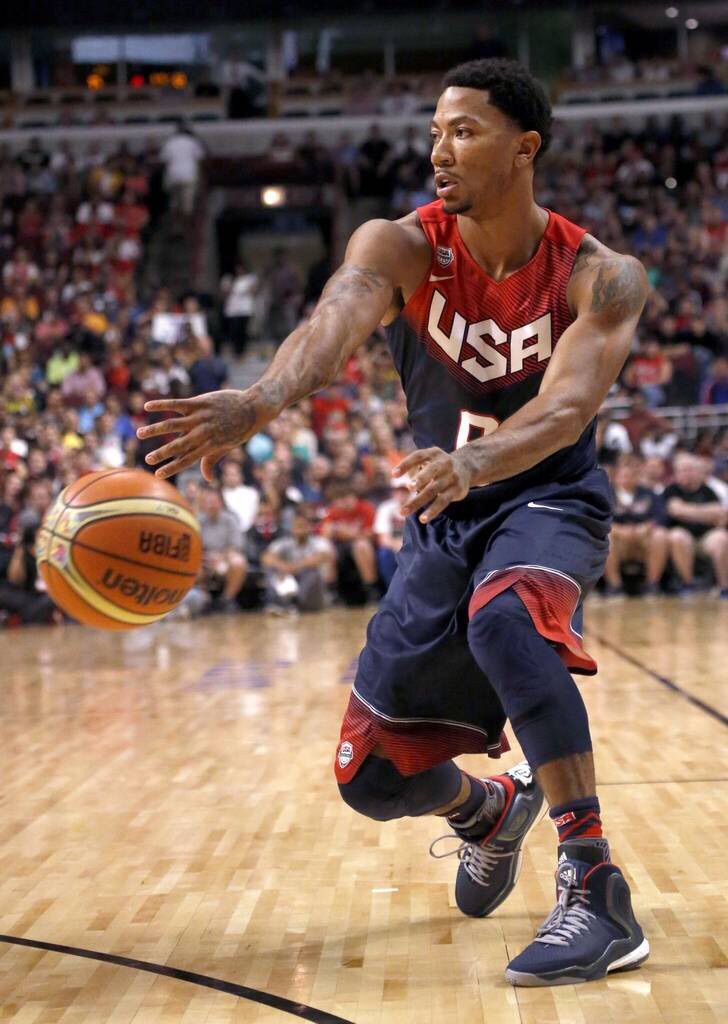 Of course, I have some status, but I have never been proud.
Of course, I have some status, but I have never been proud.
— By the way, how do you assess the current situation in the club from Los Angeles?
- They have a lot of young players who clearly understand their roles. The team was created long and painstakingly. The Clippers are one of the few clubs in the NBA that I like. We can say that their style of play is very close to European. There are at least four players who play the European way in one way or another: share the ball, look for a more comfortable position, help partners. Among them, for example, Patrick Beverly, who performed in Russia.
The opposite is the Lakers. I didn't like their decision to acquire LeBron James at all.
- Explain your opinion.
- Over the past two years, the team has been recruiting young players to develop them along the lines of the head coach's vision. Ingram, Kuzma, Ball, Hart ... LeBron came, who now commands everyone and tells who and what to do. Look at that segment when the team played without James, who was injured. They made their own decisions, they thought for themselves. I really liked this segment. LeBron is back - again, together with Rondo (the star point guard of the Lakers. - Izvestia), they move the chips. Luke Walton's role as head coach has been greatly reduced.
Look at that segment when the team played without James, who was injured. They made their own decisions, they thought for themselves. I really liked this segment. LeBron is back - again, together with Rondo (the star point guard of the Lakers. - Izvestia), they move the chips. Luke Walton's role as head coach has been greatly reduced.
- Lakers president Magic Johnson can't handle LeBron either?
- He makes certain decisions, but James is too big a figure. If he appears in any organization, this is no accident and one must wait for some events. You could say that LeBron makes decisions at the level of the Magic. I have a lot of respect for LeBron, two or three years ago I liked him less. Now he is on par with Michael Jordan and Kobe Bryant. But when it comes to style of play, James doesn't fit the Lakers. Too many players gathered in one piece to "lie down" under it. Either he doesn't fit the team, or the team doesn't fit him.
— When Timofey Mozgov played in Los Angeles, did you communicate?
- We saw each other a couple of times, but did not communicate.
— Why do you think he fails to reach the level of play that he showed in Denver or New York?
- To be honest, I don't follow his career.
- You must be following Alexei Shved. Isn't he too early to return to Europe?
- I don't think it's too early. He shows excellent results, became the best sniper of the Euroleague. I don't remember a Russian player showing similar results. Will he go to the NBA for the second time? It's up to him to decide. I know that he loves the USA, he is comfortable here, but there should be a puzzle that suits him completely: playing time, a good contract.
Let me remind you again that the NBA and Europe are completely different styles and they continue to move away from each other.
- What is the increase in divergence?
- In Europe, the interests of the team are put higher. The team has goals, tasks, the head is the coach who leads. The NBA is getting bigger and bigger.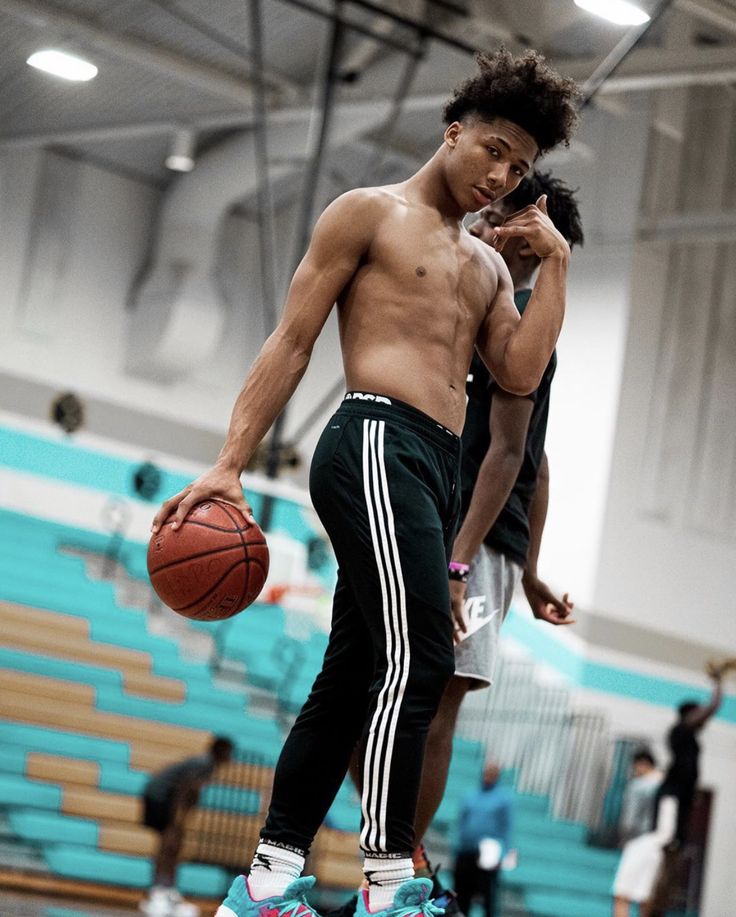 Players decide everything, everyone adapts to them. Players create the mood, they do what they want. In the NBA, basketball players don't focus on defense, everyone only looks at offense. In almost all matches, both teams score 100 points each.
Players decide everything, everyone adapts to them. Players create the mood, they do what they want. In the NBA, basketball players don't focus on defense, everyone only looks at offense. In almost all matches, both teams score 100 points each.
No one wants to enter the three-second zone, everyone is standing and playing on the arc. And this, it must be noted, has a very detrimental effect on children's and youth basketball. I've played a lot of times against teams where the point guard just brings the ball forward and sends a 3-pointer head-on. At the same time, the coach does not tell him that it was a bad throw, not optimal for the team. The coach reassures the player and says that he didn’t finish with his legs, that he didn’t reach his arm, and so on. Why are the other four players needed then? The children watched the NBA, saw how James Harden plays, and decided that they, too, would only make long-range shots.
— Do you communicate with any Russian basketball players?
— We often talk to Sergei Bykov on the phone.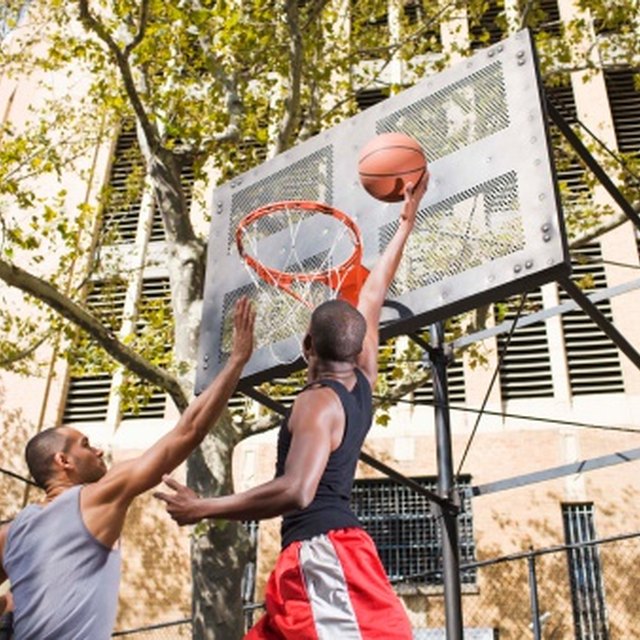 They became friends with Masha Vadeeva when she played for the Sparks. Very friendly with her brother.
They became friends with Masha Vadeeva when she played for the Sparks. Very friendly with her brother.
— What do you think about the future of Maria Vadeeva in the WNBA?
- With such data, discipline, responsibility, she has excellent chances. We must not forget that it came from European basketball, where the rules of the game are different. Masha needs to get used to the American style. If you threw the ball into the ring, then no one can tell you anything, even if you threw from the center circle. Vadeeva needs to understand this difference.
In general, if I was asked to show all American basketball in one episode, then I would no doubt point to the video where LaMelo Ball throws from the center of the field, having previously indicated that he would do just that. This is the quintessence of American basketball.
— How would you rate your career in the NBA? What was missing, what went wrong?
- First of all, I'll say that I don't think the 2005 draft was weak.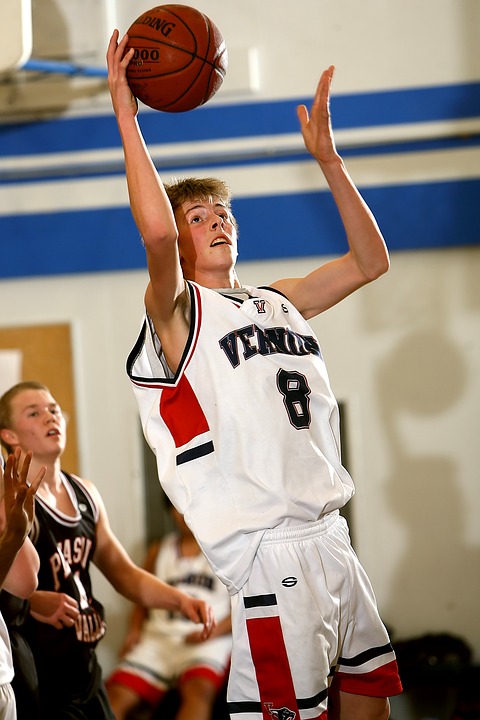 Still, the top players started to play with us: Andrew Bogut, Deron Williams, Chris Paul. Yes, and many others have achieved excellent results.
Still, the top players started to play with us: Andrew Bogut, Deron Williams, Chris Paul. Yes, and many others have achieved excellent results.
As for my career… It's all so complicated that it's impossible to describe in 2-3 sentences. It is not known what would have happened if I had stayed in Moscow. Or if I had been drafted by Boston. I don't want to use the next two arguments as excuses, but still. Firstly, I had certain problems with the Achilles (Achilles tendon. - Izvestia), which lasted quite a long time. They did not allow me to fully develop my physical abilities. After all, I was only 18 at the time. Secondly, before the NBA, I actually did not play in adult, men's basketball. I did not perform for several years, like Luka Doncic, among men, spending 15–20 minutes on the floor.
I was drafted as a prospect, but I had to fight in my position with players who were much older than me, in weight, in speed. I needed to completely rebuild. Apparently, they expected me to quickly adapt to the American style of basketball .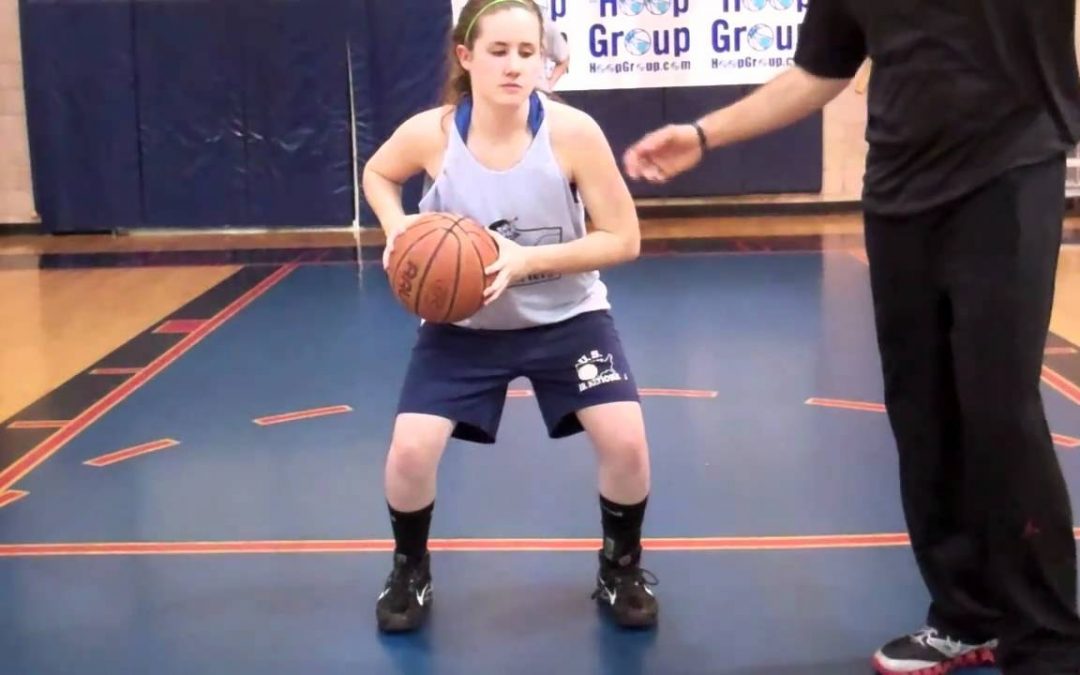 .. It is very difficult to talk about this, since there are many reasons.
.. It is very difficult to talk about this, since there are many reasons.
- Was there a chance to renew the contract with the Clippers?
- After my two-year rookie contract ended, I was called to the Clippers' management and told that they wanted to extend the agreement for another three years. That they like my game, the difficulties of my adaptation are understandable, the desire to grow is welcome. Therefore, a three-year contract was offered on different terms. Naturally, I agreed without thinking. But then the worst happened. Literally the next month, our “big” ones got injured: first Linas Kleiza, and then Elton Brand. Moreover, Elton tore his Achilles while exercising in the gym with a coach. The club's management was forced to acquire two key players, and these two could not be "thrown out" due to contracts. Therefore, I became the player that the decision was made to abandon.
- Immediately after the NBA, you came to Dynamo Moscow.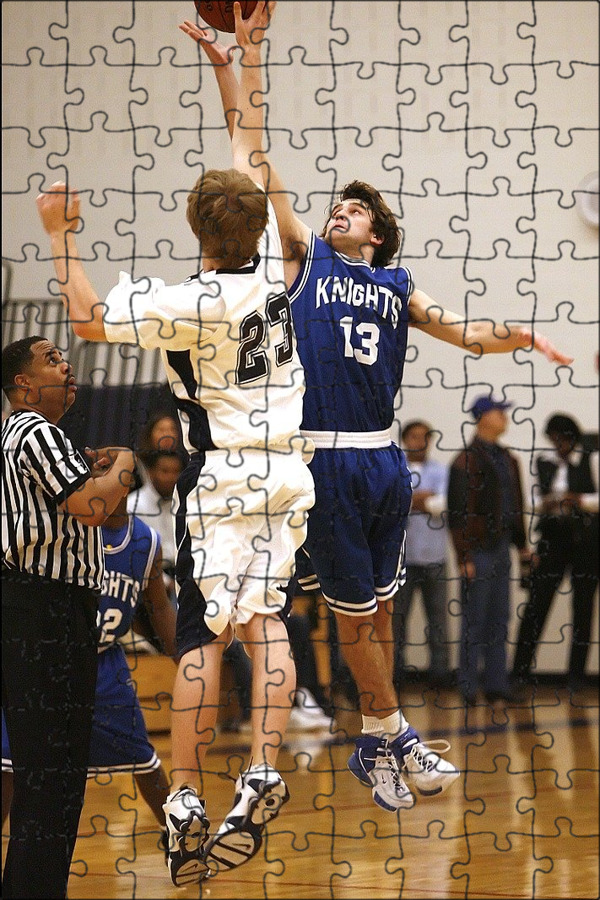 Why didn't it work out there?
Why didn't it work out there?
- We can say that this is lost time. I believe that at that moment I was ready to participate more in the gameplay. I proved it with my game. But Dynamo had a very strong squad and ambitious coaches: first Blatt, then Pesic. If I had been in a different team, perhaps I would have played more.
— Do you follow Russian basketball?
- I follow and even see a way to correct the situation. This idea is not new, but still very relevant. There should be more Russian players in domestic top clubs so that they can realize themselves. The most striking example is the Athletic football club from Bilbao. Only players born in the territory of the Basque Country are eligible to play in this team. If you were born in Madrid, then please play for Real Madrid or Atlético. If I was born in the north of Spain, I would root for Athletic, for my city, for my friends. And when it says "Central Sports Club of the Army", but in reality. ..
..
— Let's say there are two decent teams in Moscow, but there are only ten Russian players of the corresponding level. Where to get the rest?
- It seems that there are no players in Russia, they are, they need to be developed. I am by no means against foreigners, but let's remember the recent past. CSKA played in the 1990s with two foreigners, and the team was very strong. Dynamo played without foreigners and showed excellent results. Then people wanted something more, and legionnaires began to appear. Now it’s just the dominance of legionnaires, and this, by the way, is one of the reasons why parents don’t send their children to basketball.
Look at the same Spain. There are 18 teams in the Premier League. For the 40 millionth Spain there are players for 18 strong teams, but we, it turns out, do not. There are 15 clubs in Superleague-1. And there are only nine Russian teams in the United League. A little strange, isn't it?
SEE ALSO
Basketball coach from Yekaterinburg will prepare the Russian U-18 team for the European Championship in Greece It's time to move from the category of young and promising to the leaders.

Photo: BC Ural Press Service
Yekaterinburg basketball specialist Vadim Filatov has been appointed head coach of the Russian youth team (players under 18 years of age). Under his leadership, the team will perform at the European Championship, which will be held from July 27 to August 4 in Greece. Vadim Filatov, who also remains at the helm of the Yekaterinburg Ural, told the details in an interview with a correspondent for the Regional Newspaper.
- Vadim Nikolaevich, did the Russian Basketball Federation offer you to lead the national team?
- Not really. First, there was a conversation with the president of our club Stanislav Georgievich Eremin , who heads the coaching council of the RFB. He asked if I was ready, if I had a desire to lead the youth team of Russia. I took a day to think and said that I was ready to run.
- Did you have any doubts?
- I worked in this national team as an assistant to the head coach Oleg Aktsipetrov (he now helps Evgeny Pashutin in the U-19 team), so I can imagine what a huge responsibility it is.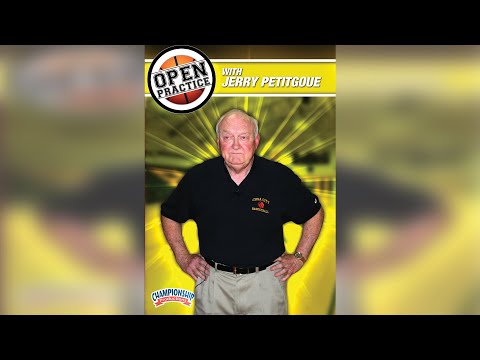 Some of the players from that team were 17 years old a year ago, so now they can get to me again. I hope there will be direct contact with Evgeny Yurievich on these issues. I doubted, because I don’t know players of this age. It's not easy - to create a team in a month and a half of preparation, we have been building the Ural game for half a year, and still not everything works out.
Some of the players from that team were 17 years old a year ago, so now they can get to me again. I hope there will be direct contact with Evgeny Yurievich on these issues. I doubted, because I don’t know players of this age. It's not easy - to create a team in a month and a half of preparation, we have been building the Ural game for half a year, and still not everything works out.
– How was the appointment procedure?
- I could not go to the meeting of the coaching council due to being busy at the club, there, as Stanislav Georgievich told me later, the votes were divided five by five between me and Denis Godlevsky from CSKA, he also helps Sergei Bazarevich in the national team. So we were both summoned to a meeting of the executive committee. He told me who I am, since it was my first official appearance at this level, a personal acquaintance with the President of the RFB Andrey Gennadyevich Kirilenko , members of the executive committee. He outlined his vision of how to build work with the team, then immediately left for the airport, because the next day Ural had an important game in Surgut. I learned in the subway that they approved me. I immediately made the first calls to discuss the plan for preparing the team.
He outlined his vision of how to build work with the team, then immediately left for the airport, because the next day Ural had an important game in Surgut. I learned in the subway that they approved me. I immediately made the first calls to discuss the plan for preparing the team.
- Due to being busy at the club, you will not be able to view potential candidates for the team. What will the selection of players look like?
- All hope for assistants, with whom we have already made a preliminary list of 25 players, and continue to expand it. One of the assistants is Dmitry Pivtsaikin , who leads the Samara-2 team, which plays in the youth tournament of the VTB United League, so I will receive all the information from him.
- What are the team's goals for the European Championship?
- Speaking to the members of the executive committee, I myself said that the task is to fight for the highest places. Otherwise, it makes no sense to go to the site. We will educate the children in the spirit of winners. We can be inferior to our rivals in “physics” (I know that France has a very powerful team, tall, physically strong players), but we have no right to be inferior in character. Tall sticks are easier to break in half. At this age there are talented players, so I'm sure that we will succeed.
Otherwise, it makes no sense to go to the site. We will educate the children in the spirit of winners. We can be inferior to our rivals in “physics” (I know that France has a very powerful team, tall, physically strong players), but we have no right to be inferior in character. Tall sticks are easier to break in half. At this age there are talented players, so I'm sure that we will succeed.
- Now a less pleasant question: in the game you mentioned with Surgut University-Ugra - one of the main competitors in the fight for getting into the playoffs - Ural had a 10-point advantage before the last quarter and lost in the last seconds 91:92. What happened?
- Ineptly played the ending, gave the opponent the won match. We absolutely did not cope with the best sniper of the league Nikola Lepoevich , who gave us 40 points, seven of them in the last two attacks. We played tactically incorrectly in the last attack of the hosts - we should have fouled Lepoevich a second earlier. As a result, he scored us three points with a foul. A very disappointing defeat, we played well for 38 minutes and in the last two minutes ... I admit that I believed in victory too early.
As a result, he scored us three points with a foul. A very disappointing defeat, we played well for 38 minutes and in the last two minutes ... I admit that I believed in victory too early.
– Mandall Thomas started off hard but eventually became the leader of the team. How does the recently arrived second American - Stefan Brown - show himself?
- He finds himself, and the game in Surgut showed this. We had serious problems with the line-up in the position of the first "number", we carefully selected the player - someone refused, someone did not suit us. We opted for Brown, and I think he will help us. Serdar Annaev , who played at the limit, he will definitely unload. There are many microtraumas in our team, but this is part of our work.
- The defeat in Surgut made it difficult for Ural to complete the task of getting into the top eight. Are there still chances?
- There will be chances until the last game.